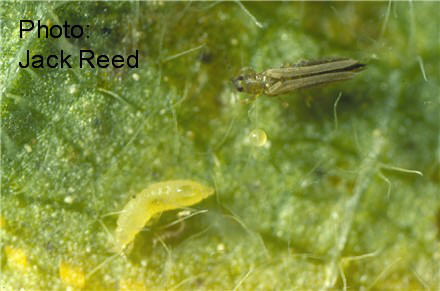Cotton Thrips Update
go.ncsu.edu/readext?299031
en Español / em Português
El inglés es el idioma de control de esta página. En la medida en que haya algún conflicto entre la traducción al inglés y la traducción, el inglés prevalece.
Al hacer clic en el enlace de traducción se activa un servicio de traducción gratuito para convertir la página al español. Al igual que con cualquier traducción por Internet, la conversión no es sensible al contexto y puede que no traduzca el texto en su significado original. NC State Extension no garantiza la exactitud del texto traducido. Por favor, tenga en cuenta que algunas aplicaciones y/o servicios pueden no funcionar como se espera cuando se traducen.
Português
Inglês é o idioma de controle desta página. Na medida que haja algum conflito entre o texto original em Inglês e a tradução, o Inglês prevalece.
Ao clicar no link de tradução, um serviço gratuito de tradução será ativado para converter a página para o Português. Como em qualquer tradução pela internet, a conversão não é sensivel ao contexto e pode não ocorrer a tradução para o significado orginal. O serviço de Extensão da Carolina do Norte (NC State Extension) não garante a exatidão do texto traduzido. Por favor, observe que algumas funções ou serviços podem não funcionar como esperado após a tradução.
English
English is the controlling language of this page. To the extent there is any conflict between the English text and the translation, English controls.
Clicking on the translation link activates a free translation service to convert the page to Spanish. As with any Internet translation, the conversion is not context-sensitive and may not translate the text to its original meaning. NC State Extension does not guarantee the accuracy of the translated text. Please note that some applications and/or services may not function as expected when translated.
Collapse ▲As predicted in a previous article, colonization of our earliest planted cotton by thrips is light at this point. Thrips are in the system and colonizing, but we have yet to experience the heavy flights from third and fourth generation tobacco thrips. They will show up. Dr. Ames Herbert has been monitoring volunteer peanuts in Suffolk, VA, which are loaded with tobacco thrips. This means that cotton planted now (mid-May) and on into June will probably be at risk for the heaviest thrips colonization events. You can protect your cotton by applying a foliar overspray of acephate at the first true leaf stage, even if you used an insecticidal seed treatment. Also, since resistance to insecticidal seed treatments has been detected in the Midsouth (not in the Southeast), this will provide us a good way to delay resistance, since we are applying a different type of chemistry to the plant as a spray.
With that in mind, we still need to protect our earliest planted cotton with a foliar overspray, as well. Plant growth has probably slowed with this stretch of dry weather and cooling conditions might hamper this some more. If Admire Pro was applied in-furrow with an insecticidal seed treatment, I would suggest scouting the cotton to see if larval thrips populations are developing. You should scout several places in the field and pull up at least 10 plants in these places, carefully inspecting the bottom leaves for adults and larvae. Sprays should not be based on adults, as these are the colonizers. Wait to spray until you notice two larval thrips per seedling. Hopefully, as has been shown in replicated studies, fields planted with an insecticidal seed treatment and Admire Pro in furrow will not require a foliar overspray. However, until we get a year or two under our belt, we won’t know how effective this tactic is over a widespread area.



